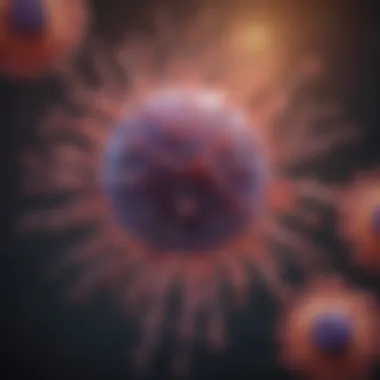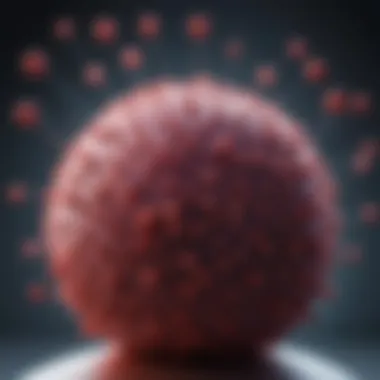T Cell Receptor Cancer Treatment: Insights and Advances


Intro
T cell receptor (TCR) therapy has emerged as a significant mechanism in the fight against cancer. This technique harnesses the body’s own immune system, specifically T cells, to target and eliminate cancer cells. The recent advances in this field have created new possibilities for treating multiple forms of malignancies. Understanding the underlying mechanisms, applications, and challenges of TCR cancer treatment is crucial for students, researchers, educators, and professionals alike.
Scientists have found that T cell receptors can be engineered to recognize specific antigens present on cancer cells. This specificity boosts the chance of targeting malignancies without harming healthy tissue. As research continues to unfold, the relevance of TCR therapy in oncology becomes more apparent, leading to better outcomes for patients. The implications of TCR cancer treatment extend not only to individual patients but also to the broader landscape of cancer treatment options.
In the following sections, we will delver deeper into key findings from recent research, implications of these results in the real world, and challenges that remain. By exploring the intricate details of T cell receptor therapy, this article aims to provide a well-rounded understanding of its impact on modern oncology.
Preface to T Cell Receptor Therapy
T cell receptor therapy is gaining attention as a promising approach in cancer treatment. It utilizes the body's immune system to identify and destroy cancer cells, offering an innovative alternative to traditional therapies such as chemotherapy and radiation. This introduction sets the stage for a comprehensive exploration of T cell receptor therapy, highlighting its significance, functionality, and advantages.
The primary mechanism of T cell receptor therapy hinges on the unique ability of T cells to recognize specific antigens presented by cancer cells. By engineering these receptors, clinicians can enhance the natural capability of T cells, leading to targeted and effective responses against tumors. This is particularly beneficial in a landscape where cancer heterogeneity poses challenges for conventional treatments.
One major benefit of T cell receptor therapy is its potential for lasting immune memory. Unlike standard chemotherapy, which often indiscriminately destroys both healthy and malignant cells, T cell therapies selectively target and kill cancer cells while sparing surrounding tissues. This specificity can reduce the side effects commonly associated with other treatment modalities. Moreover, advances in technology have made it feasible to personalize T cell therapy, tailoring treatments according to the unique characteristics of a patient's tumor, which may enhance efficacy.
Several considerations are essential when exploring T cell receptor therapy. The preparation of T cells for therapeutic use involves complex procedures, including genetic modification and proper screening. This process may yield challenges such as scalability and increased costs, which are important in the context of healthcare accessibility. Additionally, different patients may respond differently to the treatment depending on their individual genetic and tumor backgrounds. Understanding these nuances can provide valuable insights into optimizing treatment protocols.
The next sections will delve into the definition of T cell receptors, explore their historical context within cancer treatments, and provide a detailed understanding of their mechanisms of action and applications in oncology.
Mechanisms of Action
Understanding the mechanisms of action in T cell receptor therapy is crucial in grasping how these treatments target and eradicate cancer cells. A detailed exploration of these mechanisms reveals the intricate processes by which T cells are activated and how they respond to cancer-specific antigens. Such knowledge not only enhances our comprehension of the therapy's efficacy but also highlights limitations and areas for future improvements.
T Cell Activation and Function
T cell activation begins when a T cell encounters a foreign antigen presenting cell that displays a peptide fragment of the antigen on its major histocompatibility complex (MHC) molecule. This binding is a critical first step in T cell function. Once activated, T cells proliferate and differentiate into various subtypes, including effector T cells and memory T cells.
Effector T cells play a vital role in directly combating tumors by releasing cytotoxic granules containing perforin and granzymes. These molecules induce apoptosis in cancer cells. Meanwhile, memory T cells provide long-lasting immunity. They remember the specific antigens and can quickly respond to future exposures, which is essential for preventing cancer recurrence. It is important to recognize that without proper activation, T cells remain ineffective. Thus, understanding activation signals is fundamental for optimizing T cell therapies.
The Role of Antigens in T Cell Response
Antigens are molecules that provoke an immune response. In the context of T cell therapy, tumor-specific antigens are especially significant. These antigens may arise from mutated proteins or overexpressed normal proteins on the surface of cancer cells. The recognition of these antigens by T cells is what distinguishes cancer cells from normal cells, allowing the immune system to execute a targeted attack.
One notable aspect is the type of antigens recognized by T cells. Neoantigens, which are unique to tumor cells, present a promising avenue for therapy. They are often derived from mutations in cancer cells that are not found in normal tissue. As a result, they can activate T cells specifically against tumor cells while sparing normal cells, minimizing potential side effects.
"The identification of specific tumor antigens is critical for the development of personalized T cell therapies."
The complexities of antigen presentation necessitate that researchers thoroughly understand how to effectively harness the T cell response. Advances in technology, such as artificial intelligence, are currently being deployed to predict and identify these neoantigens. Overall, the mechanisms by which T cells are activated, and how they engage with antigens, are foundational to the success of T cell receptor therapies in treating cancer.
Types of T Cell Receptor Therapy
T cell receptor therapy represents an innovative frontier in cancer treatment. Understanding the different types of T cell receptor therapies is critical to appreciating their unique roles in immunotherapy. Each type has specific mechanisms, benefits, and challenges associated with it. The two principal varieties discussed here are Chimeric Antigen Receptor T Cells and T Cell Receptor Therapy itself. This knowledge is essential for clinicians and researchers in effectively utilizing these therapies for their patients.
Chimeric Antigen Receptor T Cells (CAR-T)
Chimeric Antigen Receptor T Cells, known as CAR-T cells, have gained significant attention in oncology. This therapy involves engineering a patient's T cells to express a receptor that recognizes cancer-specific antigens. By modifying T cells, the hope is to enhance their ability to target and kill cancer cells.


The process begins with the collection of T cells from the patient's blood. Subsequently, these cells undergo genetic modification using viral vectors. The resulting CAR-T cells are then proliferated in a lab and infused back into the patient.
This technique has shown remarkable success in treating certain blood cancers, such as acute lymphoblastic leukemia and some forms of lymphoma. One of the key advantages is the ability of CAR-T cells to persist in the body for extended periods, potentially providing long-term remission. However, there are considerations; toxicities such as cytokine release syndrome and neurotoxicity can occur, underscoring the need for close monitoring.
"CAR-T therapy has transformed the treatment landscape for specific hematological malignancies, showcasing the potential of personalized immunotherapy."
T Cell Receptor (TCR) Therapy
T Cell Receptor Therapy, or TCR therapy, represents another approach in immunotherapy. While similar to CAR-T, TCR therapy focuses on the natural T cell receptors that recognize specific peptide antigens presented by Major Histocompatibility Complex (MHC) molecules on cancer cells. The goal is to enhance the T cell's ability to detect and eradicate tumors.
In TCR therapy, T cells are isolated and engineered to express receptors that are specific to tumor-associated antigens. This specificity allows TCR-engineered T cells to target a broader range of cancers, including solid tumors, which are often resistant to CAR-T therapy.
The complexity here lies in the identification of unique tumor antigens and engineering TCRs to recognize them effectively. While TCR therapy has shown promise, challenges remain, such as developing scalable production methods and managing potential off-target effects.
TCR therapies are still largely experimental and under clinical investigation, but they hold great potential for future cancer treatments. The ongoing research seeks to improve the effectiveness and safety of TCR therapy for a wider array of cancer patients.
In summary, both Chimeric Antigen Receptor T Cells and T Cell Receptor Therapy are pivotal elements in the landscape of immunotherapy. They present unique opportunities and challenges that warrant careful exploration as researchers seek to refine these innovative treatments.
Development and Engineering of T Cell Therapies
The development and engineering of T cell therapies represent a pivotal area in cancer treatment. These therapies harness the immune system's intrinsic ability to identify and attack malignant cells. Genetic manipulation allows scientists to tailor T cells to recognize specific tumor antigens, ultimately leading to improved therapeutic outcomes. Understanding the nuances of T cell engineering can help elucidate why these strategies are becoming central to modern oncology.
Genetic Engineering Techniques
Genetic engineering techniques have evolved significantly in recent years, contributing to the advancement of T cell receptor therapy. Some of the predominant methods used include:
- CRISPR-Cas9: This system allows for precise editing of the genome. Researchers can add or remove genes in T cells to enhance their efficacy against cancers.
- Viral Vectors: These are often used to introduce new genes into T cells. They carry the genetic code for T cell receptors that specifically target cancerous cells, such as those in melanoma or leukemia.
- mRNA Technology: This involves transcribing the desired protein from DNA, allowing T cells to produce specific receptors that recognize tumor-specific antigens.
Each approach presents unique advantages. CRISPR-Cas9 can create multiple changes simultaneously, while viral vectors have shown a proven track record in previous trials. mRNA technology has gained traction for its adaptability and speed in developing new T cell treatments. All these techniques are essential for creating effective T cell therapies that can target various cancers.
Challenges in Engineering T Cells
Despite the advancements in genetic engineering techniques, several challenges remain in the engineering of T cells:
- Tumor Microenvironment: Cancerous tumors can create hostile environments that suppress T cell activity. This can lead to diminished effectiveness of the engineered T cells.
- Antigen Heterogeneity: Tumors are often genetically diverse. This diversity means that even if T cells target certain antigens, some cancer cells may evade detection due to variations.
- Cytokine Release Syndrome: This is a severe side effect that can occur when engineered T cells activate other immune cells in large numbers, sometimes leading to life-threatening complications.
- Regulatory Challenges: The process of approving these therapies is stringent and lengthy. Many innovative therapies face delays in regulatory assessments, hindering patient access.
Addressing these challenges requires ongoing research and collaboration among scientists, clinicians, and regulatory bodies. Progress in these areas is vital for optimizing T cell therapies, ensuring that they become a widely available treatment option for cancer patients.
"T cell therapy is not just about attacking the cancer; it's about understanding the complexities of the immune system and how it interacts with tumors."
Overall, the engineering of T cell therapies is a multifaceted endeavor that continues to shape cancer treatment paradigms. By utilizing genetic advancements and addressing existing challenges, the potential for T cell receptor therapies in oncology appears substantial.
Clinical Applications of T Cell Receptor Therapy
The clinical applications of T cell receptor therapy represent a significant advancement in the field of oncology. This treatment strategy aims to harness the power of the immune system to specifically target and eliminate cancer cells. By focusing on the unique antigens presented by tumors, T cell receptor therapy enables a more personalized approach to cancer treatment. It combines efficacy with the potential for fewer side effects compared to conventional therapies, making it of critical importance in modern oncology.
Success Stories in Oncology
The success of T cell receptor therapy can be underscored by several notable cases. Patients who have undergone therapies such as CAR-T cell treatment have shown remarkable recoveries.


- For instance, patients with acute lymphoblastic leukemia have often reached remission after treatment, a feat not commonly seen with traditional chemotherapy.
- In another example, individuals with certain types of lymphoma have experienced durable responses to T cell therapies, leading to extended periods of remission.
These cases highlight how T cell receptor therapy can change the landscape of treatment options for patients, especially those who have exhausted other therapies. The emphasis on personalized medicine further enhances its appeal, as therapies can be tailored according to the specific tumor characteristics of individual patients.
Case Studies and Patient Outcomes
When examining patient outcomes from various clinical trials, it becomes clear that T cell receptor therapy delivers an array of results. A detailed review of clinical trials provides insight into effectiveness and long-term benefits.
- A study published in "New England Journal of Medicine" reported that over 80% of patients with refractory lymphomas responded positively to T cell therapy, with a significant percentage achieving complete remission.
- In another case, a trial involving solid tumors demonstrated that 40% of participants experienced disease stabilization, showcasing the capability of this therapy beyond hematologic malignancies.
Moreover, health care providers continue to monitor these outcomes to understand better the long-term effects and potential for relapse. It is important to understand that while many patients benefit, some may experience limited effects or relapse after initial response. Thus, ongoing research is vital.
"T cell receptor therapy is paving the way for innovative cancer treatments, showing promise especially for patients with limited options."
These clinical applications and documented outcomes reinforce the critical role T cell receptor therapy plays in changing oncology's treatment paradigms.
Limitations and Risks of T Cell Therapy
The development of T cell therapy has opened new avenues in the fight against cancer. However, it is essential to recognize the limitations and risks associated with these innovative treatments. Understanding these aspects is crucial for evaluating the overall effectiveness and safety of T cell receptor therapies. Clinicians, patients, and researchers must weigh the potential benefits against the adverse effects that can arise in specific scenarios.
Potential Side Effects
T cell therapies can indeed be revolutionary, but they are not without significant side effects. Here are some of the most commonly encountered issues:
- Cytokine Release Syndrome (CRS): This reaction can occur when T cells activate and release large amounts of cytokines into the bloodstream. Symptoms may range from mild flu-like symptoms to severe complications, even leading to life-threatening conditions.
- Neurological Toxicity: Some patients may experience confusion, difficulty speaking, or seizures after treatment. These side effects can result from the impact of T cell therapy on the central nervous system.
- Infections: The modulation of the immune system may increase a patient's susceptibility to infections. This can be particularly concerning when using CAR-T cells, which can severely affect immune responses.
- Autoimmune Responses: The risk of T cells attacking healthy tissues instead of cancerous ones can lead to autoimmune conditions. This risk underscores the delicate balance that must be maintained in immune modulation.
These side effects are critical considerations when approaching T cell therapies as they can affect patient quality of life and treatment compliance.
T Cell Exhaustion and Resistance
Despite the promise of T cell therapies, a phenomenon known as T cell exhaustion poses a significant challenge. T cell exhaustion occurs when T cells become functionally impaired due to persistent antigen exposure. Several key factors contribute to this phenomenon:
- Chronic Antigen Stimulation: As T cells continuously interact with tumor antigens, they can lose their ability to function effectively. This leads to reduced cytokine production and therefore weaker anti-tumor activity.
- Regulatory Mechanisms: Tumors can exploit regulatory pathways to induce T cell exhaustion, effectively protecting themselves from immune attacks.
- Checkpoint Inhibitor Expression: High levels of inhibitory receptors, such as PD-1 and CTLA-4, can signal T cells to diminish their response to tumor cells, leading to a state of functional incapacity.
Understanding and combating T cell exhaustion is critical for improving treatment outcomes in cancer therapy.
The emergence of resistance to T cell therapies is a pressing concern. Some tumors can develop mutations or alter their antigen presentation to evade detection and destruction by T cells. Continual research into the mechanisms of resistance is essential to enhance the success of T cell therapies.
In summary, the limitations and risks associated with T cell receptor therapy are substantial. Addressing side effects, understanding T cell exhaustion, and resistance mechanisms are key to harnessing the full potential of these therapies in effective cancer treatment.
Future Directions in T Cell Receptor Therapy
The field of T cell receptor therapy is evolving rapidly. Future directions in this area are critical as they promise not only enhanced treatment efficacy but also personalized approaches to immunotherapy. Understanding these trends can guide the development of better therapeutic strategies and improve patient outcomes. Researchers are actively exploring several avenues that can increase the potential of T cell therapies in cancer treatment.
Innovations and Research Trends
Research trends in T cell receptor therapy are increasingly focused on innovative approaches to design, implement, and monitor therapies. Recent advancements include developments in bispecific T cell engagers (BiTEs) that harness the power of T cells more effectively. These agents bind to two different targets, one on the T cell and another on the cancer cell, enhancing the immunological response against tumors.
Another significant trend is the use of next-generation sequencing to identify neoantigens. Neoantigens are tumor-specific mutations that can provide potential targets for T cell therapies. This strategy not only personalizes treatment but also maximizes the specificity and safety by focusing on unique tumor profiles.


Moreover, research is delving into the field of cellular memory. Enhancing T cells’ memory capabilities could lead to more durable responses against cancer. Scientists are investigating how T cell subsets can be modified to establish long-term immune surveillance against tumors.
Combination Therapies and Synergy
The concept of combination therapies is gaining traction in T cell receptor therapy. This strategy involves using multiple therapeutic agents to achieve a synergistic effect against cancer. By combining T cell therapies with other modalities, such as checkpoint inhibitors or conventional chemotherapy, researchers aim to overcome limitations faced by single-agent treatments.
Combination therapies may address challenges like T cell exhaustion, where T cells lose functionality over time. For example, using checkpoint inhibitors alongside T cell receptor therapy can reinvigorate exhausted T cells, potentially restoring their ability to attack cancer cells.
Additionally, scientists are exploring the integration of T cell receptor therapy with targeted therapies that inhibit specific oncogenic pathways. This approach may provide a multifaceted attack on tumors, reducing the likelihood of resistance.
In summary, the future of T cell receptor therapy is poised for groundbreaking advancements. Innovations in design and application, as well as combination therapies, will likely shape the next wave of cancer treatments. Continuous research in these areas is essential for translating potential strategies into effective clinical outcomes.
"As science merges with technology, the possibilities for enhancing T cell therapies seem boundless."
By understanding these future directions, stakeholders in healthcare can better prepare for the transformation of cancer therapy through T cell receptor advancements.
Ethical Considerations
The exploration of T cell receptor therapy in cancer treatment brings forth significant ethical considerations. This area of medical innovation does not merely revolve around the biological aspects but also encompasses the moral and social implications tied to its application. As therapies evolve, the stakes involve patient rights, genetic manipulation ethics, and broader societal impacts. Addressing these ethical dimensions is crucial to ensure that the advancements in T cell therapies benefit all members of society and align with fundamental ethical principles.
Ethics in Genetic Manipulation
Genetic manipulation forms the core of T cell receptor therapy. The ability to modify T cells genetically for the purpose of cancer treatment can lead to significant improvements in patient outcomes. However, this technological power raises ethical questions about how far manipulation should go.
Key considerations include:
- Safety and Harm: Will edited T cells cause unintended harm? The long-term effects of genetic changes remain uncertain.
- Consent: Patients must be adequately informed about the risks of genetic manipulation. Ensuring comprehensive understanding is essential for obtaining genuine consent.
- Natural Order: Some argue that altering human genetics disrupts natural biological processes, posing moral dilemmas about what constitutes acceptable intervention.
"The advancements in genetic engineering must be scrutinized not just for their scientific merit, but for their alignment with ethical norms and patient welfare."
These factors necessitate ongoing dialogue among researchers, ethicists, and the public to navigate the complexities of genetic manipulation in T cell therapies. The aim is to create frameworks that not only allow innovation but also prioritize ethical integrity.
Access and Equity in Cancer Treatment
As T cell receptor therapies advance, issues of access and equity become paramount. The high costs associated with T cell therapies can create disparities, where only certain populations benefit from these cutting-edge treatments. This creates an ethical dilemma regarding justice in healthcare.
Important aspects include:
- Cost Barriers: Many patients may struggle to afford these therapies, leading to inequitable treatment options based on socio-economic status.
- Geographic Disparities: Not all healthcare facilities offer advanced T cell therapies, which may leave rural or underserved populations at a disadvantage.
- Equity in Research: It is crucial that diverse groups are represented in clinical trials to ensure treatments are effective across various demographics.
Proponents argue for the implementation of policies that promote equitable healthcare access. This might include insurance reforms or government interventions that make T cell therapies affordable and available to all who need them.
In summary, ethical considerations surrounding T cell receptor therapy are profound and multifaceted. As the field grows, fostering discussions on genetic manipulation and equity in access will be crucial in shaping a future where these therapies are responsibly integrated into cancer treatment.
Closure
Summation of Key Points
T Cell Receptor therapy represents a significant advancement in cancer treatment. It operates on the premise of harnessing the body's immune system to identify and destroy cancer cells. One crucial aspect of this therapy is its ability to tailor the immune response specifically against cancer antigens, enhancing the effectiveness of treatment. Key points discussed include:
- Mechanism of Action: Understanding how T cells recognize and attack cancer cells is critical. This requires knowledge of the T cell activation process and the role of specific antigens.
- Types of Therapies: The article elaborated on both Chimeric Antigen Receptor T Cells and T Cell Receptor Therapy, emphasizing the unique approaches and technologies involved in each type.
- Clinical Applications: Case studies show promising results, underscoring therapeutic successes in various cancers, notably hematologic malignancies.
- Limitations and Risks: Addressed potential side effects and issues such as T cell exhaustion, which can hinder treatment efficacy.
- Ethics: Discussions on genetic manipulation and ensuring equitable access to treatments are essential considerations moving forward.
The Future of T Cell Receptor Therapy
The development of T Cell Receptor therapy is still in its infancy, and the future looks promising. Ongoing research is exploring novel genetic engineering techniques to enhance T cell responses. The integration of combination therapies, where T cell therapy is used alongside traditional treatments, may lead to synergistic effects that improve patient outcomes. Continuous improvements in manufacturing processes and a greater understanding of T cell biology may also lead to more personalized treatment approaches.







